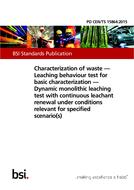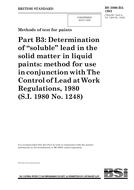
BS PD CEN/TS 15864:2015
Click here to purchase
BS PD CEN/TS 15864:2015 is applicable for determining the leaching behaviour of monolithic wastesunder dynamic conditions. The test is performed under experimental conditions relevant to assess theleaching behaviour in view of the considered scenario(s). This test is aimed at determining the releaseas a function of time of inorganic constituents from a monolithic waste, when it is put into contact withan aqueous solution (leachant).
In general, the composition, the temperature and the continuous renewal rate of the leachant arechosen such that the leaching behaviour of the waste material can be studied in view of the considereddisposal or recovery scenario. When the release needs to be determined without any reference to aspecific scenario, the leachant is demineralized water, the temperature and the continuous renewal rateare fixed.
This dynamic monolithic leaching test (DMLT) is a parameter specific test as specified in EN 12920 andis therefore not aimed at simulating real situations. The application of this test method alone is notsufficient for the determination of the detailed leaching behaviour of a monolithic waste under specifiedconditions.
In the framework of EN 12920 and in combination with additional chemical information, the test resultsare used to identify the leaching mechanisms and their relative importance. The intrinsic properties canbe used to predict the release of constituents at a given time frame, in order to assess the leachingbehaviour of monolithic waste materials, placed in different situations or scenarios (including disposaland recycling scenarios).
The test method applies to regularly shaped test portions of monolithic wastes with minimumdimensions of 40 mm in all directions that are assumed to maintain their integrity over a time framerelevant for the considered scenario. The test method applies to test portions for which the geometricsurface area can be determined with the help of simple geometric equations. The test method applies tolow permeable monolithic materials.
NOTE 1 If, in order to comply with the requirements of regular shape, the test portion is prepared by cutting orcoring, then new surfaces are exposed which can lead to change(s) in leaching properties. On the other hand if thetest portion is prepared by moulding, the surface will be dependent to the type of mould and the conditions ofstorage. If the intention is to evaluate the behaviour of the material core, the specimen needs to be stored withoutany contact with air to avoid carbonation.
NOTE 2 For monolithic waste materials with a saturated hydraulic conductivity higher than 10-8 m·s-1, water islikely to percolate through the monolith rather than flow around it. In such cases, relating the release to thegeometric surface can lead to misinterpretation. A percolation test is then more appropriate (e.g. CEN/TS 14405).
This procedure may not be applicable to materials reacting with the leachant, leading for example toexcessive gas emission or an excessive heat release.
This document has been developed to determine the release of mainly inorganic constituents fromwastes. It does not take into account the particular characteristics of organic constituents nor theconsequences of microbiological processes in organic degradable wastes.
Cross References:
EN 14346
EN 15002
EN 16192
EN ISO 3696
ISO 3696
EN ISO 5667-3
ISO 5667-3
EN 12457-1:2002
EN 12920:2006+A1:2008
CEN/TS 14405
EN 14429
EN 14899
EN 14997
CEN/TS 15862
EN 15863
CEN/TS 16660
AFNOR XP X30-450:2002
AFNOR XP X30-467:2002
AFNOR XP X30-469:2007
ANSI/ANS 16.1:1986
1999/31/EC
2003/33/EC
All current amendments available at time of purchase are included with the purchase of this document.
Product Details
- Published:
- 12/31/2015
- ISBN(s):
- 9780580901355
- Number of Pages:
- 40
- File Size:
- 1 file , 1.6 MB
- Product Code(s):
- 30323379, 30323379, 30323379
- Note:
- This product is unavailable in United Kingdom

